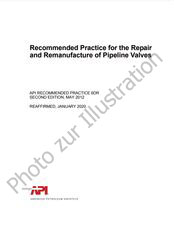Wir benötigen Ihre Einwilligung zur Verwendung der einzelnen Daten, damit Sie unter anderem Informationen zu Ihren Interessen einsehen können. Klicken Sie auf "OK", um Ihre Zustimmung zu erteilen.

Informationen über die Norm:
Bezeichnung normen: API PUBL 4262-ed.1990
Ausgabedatum normen: 1.12.1990
SKU: NS-1139751
Zahl der Seiten: 90
Gewicht ca.: 301 g (0.66 Pfund)
Land: Amerikanische technische Norm
Kategorie: Technische Normen API
Die Annotation des Normtextes API PUBL 4262-ed.1990 :
API PUBL 4262, 1990 Edition, December 1990 - Methanol Vehicle Emissions
EXECUTIVE SUMMARY
This publication (a) identifies and presents empirical data on emissions from methanol vehicles and (b) compares and evaluates emissions trends among various types of methanol vehicles over time. These emissions data are necessary to assess the impact of methanol use on ozone levels.
Researchers have tested emissions from methanol vehicles since the early 1970s, but these data have not been fully and systematically compiled, This report provides a systematic, comprehensive compilation and analysis of these data, taken from every major study of methanol vehicles for at least the last 10 years. It includes emissions measurements for 69 vehicles and organizes the data into logical subgroups that permit analysis of important emissions hypotheses.
Many of the data collected are characterized by significant uncertainties. For example, different techniques were used to measure the same kind of emission. The data are accepted at face value, though there is some indication in the literature that measurement bias has been a problem for some test procedures. Also, the data were collected from vehicles that had received care beyond what vehicles in ordinary, everyday use would receive. For example, these vehicles were more reliably maintained and repaired. This often meant replacement of key engine and emission control components. For this reason, the emissions data reported in this publication probably reflect better performance from the methanol vehicles than would be expected in common, everyday use.
Some of the emissions data collected in this report were not accompanied by odometer readings. This was a key factor in the analysis, since a lack of odometer readings made understanding of the emissions data problematic. Thus, while all of the data collected are included in Appendixes A and B, only the data with odometer readings were analyzed. Tailpipe emissions data with odometer readings were available for 54 of the 69 vehicles. A subset of this data, covering 31 of the 54 vehicles, was also analyzed.
The subset of 31 vehicles included data that were more complete, uniform, and directly comparable. Vehicles were only included when organic emission species and nitrogen oxide (NOx) emissions were measured, when vehicles were tested in their normal emission control configurations, when emissions were measured following catalyst stabilization, and when either M85 or M100 was used as the test fuel. By applying this more restrictive set of rules, we could learn more about the performance of subsets of vehicles classified by manufacturer, vintage, technology, and type of fuel used. We could also see relationships and trade-offs relating to the control of more than one kind of emission.
Despite the limitations of the data, our analysis supports several conclusions.
For M85 vehicles, those that operate on an 85-percent methanol/15-percent gasoline blend, there are sufficient recent data to characterize emissions. The data show some improvement in emissions performance for the second-generation M85 vehicles. This improvement offers encouragement that utilitarian M85 vehicles could be built that would satisfy most of the emissions criteria of the U.S. Environmental Protection Agency (EPA) and the California Air Resources Board (CARB). The data also indicate, however, that a number of emission problems and unanswered questions remain:
- a. Even at low mileage, M85 vehicles almost always exceeded the 50,000-mile 1993 California tailpipe standard of 15 milligrams per mile for formaldehyde emissions. Average formaldehyde emissions were about three times higher than this standard. At various test mileages, the older, 1981 - 1985 models had measured formaldehyde emissions below the California standard level in only 6 percent of the tests. The newer, 1986 - 1988 models were only slightly better, meeting the standard level in about one of four tests.
- b. M85 vehicles typically had nitrogen oxide emissions that were less than the 50,000-mile federal standard of 1.0 gram per mile, but they were only rarely able to meet the more stringent 50,000-mile California standard of 0.4 gram per mile, even at low mileage. Even the 1986 - 1988 models performed poorly, testing below the 0.4-gram-per-mile level just 10 percent of the time at various mileages.
- c. There was substantial improvement in meeting the 50,000-mile federal tailpipe standard of 0.41 gram per mile for organic emissions. Although the 1981 - 1985 models met this level in only 40 percent of the tests, the 1986 - 1988 models did so 90 percent of the time. However, even these newer vehicles were able to meet the 50,000-mile 1993 California standard level of 0.25 gram per mile only 40 percent of the time. No methanol vehicle was able to meet the California standards for hydrocarbon and nitrogen oxide emissions simultaneously.
- d. There was also substantial improvement in meeting the 50,000-mile federal standard for carbon monoxide of 3.4 grams per mile. The 1981 - 1985 models met the standard level about 40 percent of the time at various mileages. The 1986 - 1988 models met the standard level in more than 80 percent of the tests.
- e. At the mileages tested, M85 vehicles were generally able to meet the 50,000-mile federal standard of 2 grams per test for total organic evaporative emissions.
For M100 vehicles, that is, methanol vehicles operating on pure methanol, the da
Empfehlungen:
Aktualisierung der technischen Normen
Wollen Sie sich sicher sein, dass Sie nur die gültigen technischen Normen verwenden?
Wir bieten Ihnen eine Lösung, die Ihnen eine Monatsübersicht über die Aktualität der von Ihnen angewandten Normen sicher stellt.
Brauchen Sie mehr Informationen? Sehen Sie sich diese Seite an.



 Cookies
Cookies
